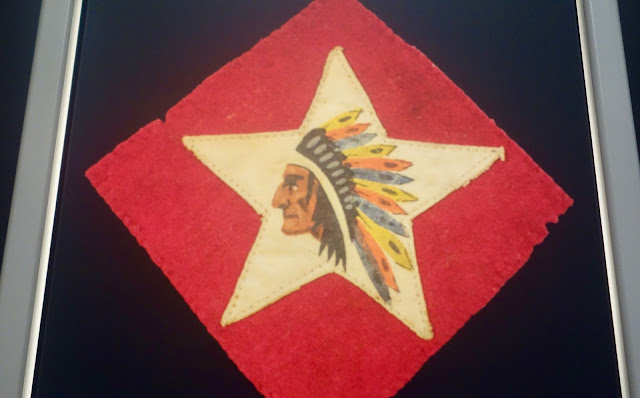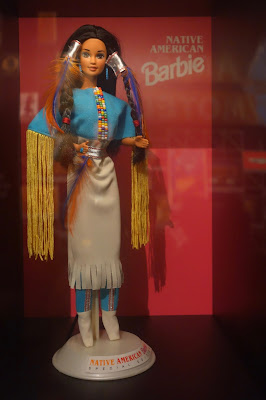 |
| President Barack Obama by Kehinde Wiley (2018) |
 |
| Michelle La Vaughn Robinson Obama by Amy Sherald (2018) |
The US government has erected some gorgeous buildings in the nation's capital.
A rave review in The New Yorker of an exhibit sent me to the National Museum of the American Indian for the first time.
"Americans" most definitely didn't disappoint although it did make me feel deeply ashamed of my ignorance of our country's indigenous population. The largest gallery depicts how Native Americans have been portrayed in popular culture.
They're found literally everywhere.
Even if they're portrayed by mostly white men in the movies. I mean Elvis, maybe, but casting Joey Bishop as an Indian ("half brave and half chicken") in a Dean Martin turkey called Texas Across The River? C'mon now!
Powerful machines and weapons have been named after Native Americans, too.
The exhibit explores three distinct themes, beginning with Little Big Horn which marked a major turning point in American history. Despite the best efforts of a well-armed US military, the Indians, led by Crazy Horse, prevailed big time. Victory instantly changed their stereotype in the public imagination from losers to winners.
Somehow General Custer ended up a "Happy Meal" toy at McDonalds' more than a century later. Go figure!
But Native arts and crafts dominate much of the display. It shocked me to realize I know more about ancient Egypt than I do the people who first settled the United States.
Look no further than appropriation of Native American lands by the federal government for evidence that money always trumps justice, even in a democracy. Despite his oratorical skills, Opothle Yoholo, a Muscogee Creek Indian chief, couldn't prevent passage of the Indian Removal Act in 1830. He and members of his tribe were among the hundred thousand Native Americans who left behind a Trail of Tears when King Cotton forced tribes living in the southeastern United States west of the Mississippi.
The uplifting but phony tale of Pocahontas illuminates 500 years of white myth making. This sculpture depicts the barely pubescent princess preventing her father, a powerful Algonquian Indian chief, from whacking Captain John Smith at Jamestown in the early 17th century.
Young red girl rescues older white guy. Soon after, she marries a tobacco farmer and converts to Christianity. The couple sails to England where the "civilized savage" charms London society but dies before her 21st birthday. No wonder Disney turned her into a revisionist icon while she means virtually nothing to her own people. Of course that hasn't stopped our ignorant President from using Pocahontas as a slur. She's arguably the most famous Native American on the planet even if it seems no two images of her look alike!
Washington looked pretty blah after "Americans."
I had time for one more stop: the East Wing of the National Gallery.
"Outliers and American Vanguard Art" posits that self-taught artists blossomed three times over the last century, producing works during periods of cultural upheaval that didn't differ so much from what many galleries were showing. Any exhibit that includes Marsden Hartley commands my attention.
Kara Walker and Horace Pippin were the only other artists I recognized.
Pippin painted this portrait of Marian Andersen who sang "My Country Tis Of Thee" at the Lincoln Memorial in 1939 after the Daughters of the American Revolution prevented her from performing a concert at Constitution Hall.
Loved his dogs in "The Den!"
But the works of many completely unfamiliar and mostly marginalized artists, working in a variety of media, left me rejecting the often arbitrary distinctions the "art world" (critics, gallery owners, curators and historians) often makes.
"Girl With Pigeons" by Morris Hirshfield:
"Contrail Crucifix" by Roger Brown:
"Toot-Toot Woo" by Jim Nutt.
Creepy but compelling sculptures by James "Son Ford" Thomas. He sings the blues, too.
"Love (Martin Luther King, Jr.)" by Elijah Pierce:
And its opposite, "Untitled (Hunter and Victim)" by Steve Ashby, who died in 1980:
"In The Wings" by Nancy Shaver:
"Untitled" quilt detail by Al Loving:
Two more quilt details by Mary Lee Bendolph. "Blocks and Strips":
"Jackie O" by Greer Lankton:
(Paradise) from the "Fall of Man" series by Edgar Tolson:

































































